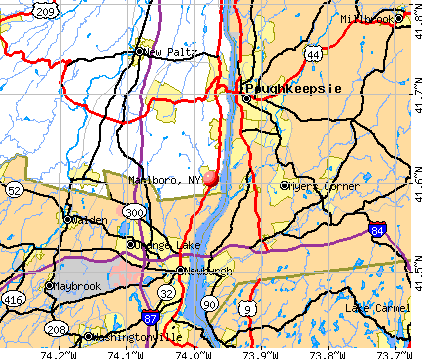

Earthquake activity: Marlboro-area historical earthquake activity is significantly above New York state average. wind speeds 207-260 mph) tornado 49.8 miles away from the place center killed 3 people and injured 24 people and caused between $5,000,000 and $50,000,000 in damages. wind speeds 158-206 mph) tornado 31.9 miles away from the Marlboro place center injured one person and caused between $500,000 and $5,000,000 in damages. The Lattingtown Baptist Church was listed on the National Register of Historic Places in 2010.Marlboro-area historical tornado activity is above New York state average.
Lattingtown – a hamlet in the western part of the town on Route 11. Milton – this hamlet is in the northeastern part of the town on Route 9W, adjacent to the Hudson River. Marlboro – this hamlet is in the southeastern part of the town on Route 9W. Baileys Gap – a hamlet at the northern town line on Route 44. About 5.8% of families and 8.2% of the population were below the poverty line, including 8.9% of those under age 18 and 9.5% of those age 65 or over.Ĭommunities and locations in Marlborough The per capita income for the town was $21,079. Males had a median income of $38,074 versus $29,608 for females. The median income for a household in the town was $49,788, and the median income for a family was $56,933. For every 100 females age 18 and over, there were 94.8 males. For every 100 females, there were 96.8 males. In the town, the population was spread out, with 26.5% under the age of 18, 7.4% from 18 to 24, 30.8% from 25 to 44, 23.5% from 45 to 64, and 11.7% who were 65 years of age or older. The average household size was 2.73 and the average family size was 3.25. 22.6% of all households were made up of individuals, and 9.1% had someone living alone who was 65 years of age or older. There were 3,020 households, out of which 36.0% had children under the age of 18 living with them, 57.1% were married couples living together, 9.5% had a female householder with no husband present, and 29% were non-families. Hispanic or Latino of any race were 3.98% of the population. 84% from other races, and 1.33% from two or more races. The racial makeup of the town was 94.48% white, 2.82% African American. There were 3,176 housing units at an average density of 127.9 per square mile (49.4/km 2). The population density was 332.8 people per square mile (128.5/km 2). The highest point is the summit of Marlboro Mountain, at 1,127 feet (344 m).ĭemographics Historical populationĪs of the census of 2000, there were 8,263 people, 3,020 households, and 2,144 families residing in the town. The lowest point in the town is the shore of the Hudson River, which is at sea level. The western border of the town closely parallels the Marlboro Mountain ridge, dividing Marlborough from the town of Plattekill. 

The eastern town line, marked by the Hudson River is the border of Dutchess County, and the southern town line is the border of Orange County. Part of the town was used to create the town of Plattekill in 1800.Īccording to the United States Census Bureau, the town has a total area of 26.5 square miles (69 km 2), of which 24.8 square miles (64 km 2) is land and 1.7 square miles (4.4 km 2) (6.3%) is water. The Town of Marlborough was formed in 1788 during a period of town formation in the county. The region was part of the Newburgh Precinct and was set apart in 1772. Perspective map of Marlborough from 1891 with list of landmarks published by L.R.







 0 kommentar(er)
0 kommentar(er)
